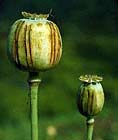Heroin and Teenagers
 A s early as 1996, it was evident that heroin use was becoming increasingly popular among younger Americans. In fact, from 1991 to 1995, heroin use among the nation’s young people roughly doubled, while the percentage of teens that considered heroin use dangerous declined. There were a variety of reasons for these shifts, perhaps none more critical than the increased purity of the drug.
A s early as 1996, it was evident that heroin use was becoming increasingly popular among younger Americans. In fact, from 1991 to 1995, heroin use among the nation’s young people roughly doubled, while the percentage of teens that considered heroin use dangerous declined. There were a variety of reasons for these shifts, perhaps none more critical than the increased purity of the drug.
Today, in the year 2004, heroin use among teenagers is still popular, although it may be harder for teens to find a heroin dealer in suburban areas since September 11, 2001. Obviously, if someone wants to find a drug enough, they will find the resources. Afghanistan’s number one export is opium, just an FYI. Eighty percent of the world’s heroin comes from Afghanistan.
A Short History of Heroin
 Heroin is an opioid derived from the dried sap of the opium poppy. Opioids have been used for euphoria and pain relief for thousands of years. Heroin is in the same category of painkillers as morphine, its derivatives and codeine. It was brought to China by Arab traders in the eighth century. In later dealings the British, East India Company became a chief supplier and promoter of opium for the Chinese market.
Heroin is an opioid derived from the dried sap of the opium poppy. Opioids have been used for euphoria and pain relief for thousands of years. Heroin is in the same category of painkillers as morphine, its derivatives and codeine. It was brought to China by Arab traders in the eighth century. In later dealings the British, East India Company became a chief supplier and promoter of opium for the Chinese market.
When heroin was first produced, it was thought it would be less addictive than morphine. This did not prove to be true. In England heroin is mixed with alcohol and given as an cocktail to terminally ill cancer patients for pain relief. In the US, the FDA will not approve it for this use, since it claims that morphine is just as effective (and that heroin is broken down by the body into morphine anyway). The photo on the left is of the opium poppy flower, it is not illegal to grow them and they are very beautiful. (Remember the poppy field in the Wizard of Oz. “Poppies will make you sleep”).
How to Recognize Heroin
 Pure heroin is a white powder that tastes really bad, but you probably won’t see it very often on the street, at school or anywhere. Most heroin sold on the street to teens and adults varies in color from white to dark brown, but most will look like light brown sugar. The color can tell you what country the drug came from. To see more photos of the different “looks” of heroin go to our drug photo page.
Pure heroin is a white powder that tastes really bad, but you probably won’t see it very often on the street, at school or anywhere. Most heroin sold on the street to teens and adults varies in color from white to dark brown, but most will look like light brown sugar. The color can tell you what country the drug came from. To see more photos of the different “looks” of heroin go to our drug photo page.
Heroin Production
 Heroin today is produce is produced in makeshift laboratories and shipped all over the world. The United States supply of heroin mostly comes from Afghanistan, Mexico, South America and Southwest Asia. The photo on the left is the opium poppy flower bulb.
Heroin today is produce is produced in makeshift laboratories and shipped all over the world. The United States supply of heroin mostly comes from Afghanistan, Mexico, South America and Southwest Asia. The photo on the left is the opium poppy flower bulb.
EFFECTS:
The effects of heroin include significant pain relief, but as dose is increased, euphoria is produced. Even at doses where there is strong euphoria, coordination and intellect are only mildly affected. Many people can function fairly ‘normally’ while on heroin, it is the withdrawal of the regular user that can kill them.
At very high doses of heroin, sedation, respiratory depression and coma may occur. People taking opioids with painful medical conditions describe knowing the pain is present, but not caring. Unfortunately tolerance quickly develops with heroin, with more and more required just to feel normal. Addiction potential is so high some users become criminals or prostitutes to support their habit. There are synthetic types of opioid medications, like Oxycodone, Vicodin, Norco,– medicines that are used for acute pain. These can become addictive when not used with care. You may become physically addicted, not psychologically. These drugs need to be weaned off of to avoid seizure. Talk to your health care provider if you have been taking these for recreational use. (Which is not legal, btw).
What is Speedballing?
Speedballing is when heroin and cocaine are injected into the body together. This is a deadly combination as it enters the body very quickly when injected into a vein. Speedballing will kill you. It is also used by “skin-popping” — injecting the drug just under the skin and not into a vein.
An FYI – I had a reader ask if it was true that the very skinny ”runway models” used heroin to stay that thin. Yes, many do. I had one who wrote me for help last year. She put herself into a rehab program. I don’t know how she is now.
To older Americans, (maybe your parents), heroin was always a drug that needed to be injected, but the more potent strands readily available today allow the drug to be smoked or sniffed. Suddenly, many people who would never consider trying heroin by injection had new options, options they perceived as less risky.
Dr. Herb Kleber, Director of The Center on Addiction And Substance Abuse (CASA), said, “non-injection makes it psychologically easier to start, removing the needle barrier and letting the individual delude himself or herself that such use is not dangerous or addicting.” However, one can die from an overdose or become addicted from these non-injecting routes as well. As the perceived risk went down, so did the age of first use of heroin. In 1991, a national survey on drug abuse put the average age of first-time heroin users at age 24. By 1995, the average first-time user was 19 years old.
![]()
The Partnership for a Drug-Free America launched a heroin abuse campaign in June 1996. The goal was and remains to de-glamorize heroin use. Today, while heroin use continues to be seen among younger and younger Americans, the average age of first use was down to 17.6 in 1997, and reports of kids as young as 13 using heroin are not unheard of. There is evidence that kids in general are joining older Americans in rejecting the drug. According to the Partnership Attitude Tracking Study (PATS), the number of teens who have tried heroin has remained stable over the past few years (in 1999, 3 percent said they tried the drug in 1999, compared with 4 percent in 1997 and 1998). The Monitoring the Future study tells a similar story; in 1999, 2.3 percent of 8th graders, 2.3 percent of 10th graders and 2 percent of 12th graders said they had tried the drug, all unchanged from 1998.
In addition, since 1996 — the year the Partnership’s campaign against heroin began — teens’ perceived risk associated with the use of heroin has increased. In 1996, PATS research found that 80 percent of 9th and 10th graders and 84 percent of 11th and 12th graders agreed strongly that heroin is a dangerously addictive drug. In 1999, the figures are 85 and 88 percent, respectively. Overall, 84 percent of teens now agree strongly that heroin is a dangerously addictive drug, and 90 percent of them strongly agree with the statement heroin can wreck your life.
Again, the Monitoring The Future study finds similar changes. In 1996, 52.5 percent of 12th graders surveyed said they saw great risk in trying heroin once or twice. In 1999, that figure stood at 56 percent. Dr. Lloyd Johnston, lead researcher for Monitoring the Future, said, The untimely deaths of several musicians and other celebrities from heroin use, as well as the media campaign against heroin, may have influenced young people’s view of how dangerous a drug this is, even if it is not being injected.
BTW , according to a recent drug abuse survey, ninety-eight percent of Americans believed that heroin was a very dangerous drug. They are correct, and yet this drug is now easy to buy & is sold in very inexpensive doses. It is very available in suburban areas of the US It is not only an inner city problem. Ten dollars worth can get 5 kids very addicted. Or kill one teen. End of story.
- Check out Heroin and its Cousins and Opioids – Sweet Relief and Danger. (Vicodin, Oxycontin, etc).
- Check out: Is Methadone the Answer to Kicking Heroin? For the webcast: On Methadone..
Some of this information was provided with permission from
Partnership for a Drug-Free America. Thank you!

